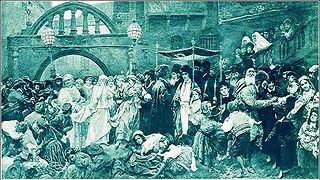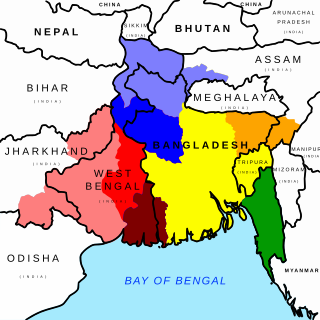
A wedding is a ceremony in which two people are united in marriage. Wedding traditions and customs vary greatly between cultures, ethnicities, races, religions, denominations, countries, social classes, and sexual orientations. Most wedding ceremonies involve an exchange of marriage vows by a couple; a presentation of a gift ; and a public proclamation of marriage by an authority figure or celebrant. Special wedding garments are often worn, and the ceremony is sometimes followed by a wedding reception. Music, poetry, prayers, or readings from religious texts or literature are also commonly incorporated into the ceremony, as well as superstitious customs.
A white wedding is a traditional formal or semi-formal wedding originating in Great Britain.
Bridesmaids are members of the bride's party at some Western traditional wedding ceremonies. A bridesmaid is typically a young woman and often the bride's close friend or relative. She attends to the bride on the day of a wedding or marriage ceremony. Traditionally, bridesmaids were chosen from unwed young women of marriageable age.

A wedding dress or bridal gown is the dress worn by the bride during a wedding ceremony. The color, style and ceremonial importance of the gown can depend on the religion and culture of the wedding participants. Wedding dresses hold a significant place in fashion, symbolizing personal expression, and cultural traditions and societal values. In Western culture, the wedding dress is most commonly white, a fashion made popular by Queen Victoria when she married in 1840. In Eastern cultures, brides often choose red to symbolize auspiciousness. These wedding dresses often represent a blend of heritage and contemporary trends, making them a pivotal aspect of bridal fashion and a reflection of evolving style in society.
The "Bridal Chorus" from the 1850 opera Lohengrin by German composer Richard Wagner, who also wrote the libretto, is a march played for the bride's entrance at many formal weddings throughout the Western world. In English-speaking countries, it is generally known as "Here Comes the Bride" or "Wedding March", but "wedding march" refers to any piece in march tempo accompanying the entrance or exit of the bride, notably Felix Mendelssohn's "Wedding March". Wagner’s piece was made popular when it was used as the processional at the wedding of Victoria the Princess Royal to Prince Frederick William of Prussia in 1858.

Felix Mendelssohn's "Wedding March" in C major, written in 1842, is one of the best known of the pieces from his suite of incidental music to Shakespeare's play A Midsummer Night's Dream. It is one of the most frequently used wedding marches, generally being played on a church pipe organ.

A Jewish wedding is a wedding ceremony that follows Jewish laws and traditions. While wedding ceremonies vary, common features of a Jewish wedding include a ketubah that is signed by two witnesses, a chuppah or huppah, a ring owned by the groom that is given to the bride under the canopy, and the breaking of a glass.
A wedding song is a song sung as wedding music

A Bengali Muslim wedding is a Bengali wedding in accordance with the Muslim faith. It includes rituals and ceremonies that may span up to three days. In most cases, it starts with the Dekha Dekhi, followed by the nikah, which is conducted by a Qazi with a fixed denmohor. It ends with the Bou Bhat ceremony, which is popular as the wedding reception arranged by the groom's family. This is the dominant tradition of weddings seen among the Bengali Muslims of Bangladesh and the West Bengal state of India.
Ukrainian wedding is the traditional marriage ceremony in Ukrainian culture, both in Ukraine and in the Ukrainian diaspora. The traditional Ukrainian wedding featured a rich assortment of folk music and singing, dancing, and visual art, with rituals dating back to the pre-Christian era. Over time, the ancient pagan traditions and symbols were integrated into Christian ones.
Arabic weddings are ceremonies of matrimony that contain Arab influences or Arabic culture.
In the United States and Canada, weddings follow traditions often based on religion, culture, and social norms. Most wedding traditions in the United States and Canada were assimilated from other, generally European, countries. Marriages in the U.S. and Canada are typically arranged by the participants and ceremonies may either be religious or civil.

Traditional marriage customs in the Philippines and Filipino wedding practices pertain to the characteristics of marriage and wedding traditions established and adhered by them Filipino men and women in the Philippines after a period of adoption courtship and engagement. These traditions extend to other countries around the world where Filipino communities exist. Kasalan is the Filipino word for "wedding", while its root word – kasal – means "marriage". The present-day character of marriages and weddings in the Philippines were primarily influenced by the permutation of Christian, both Catholic and Protestant, Hindu, Islam, Chinese, Spanish, and American models.

The traditional wedding cord, also known as the "wedding lasso", is a piece of paraphernalia used in some Catholic wedding ceremonies. It is actually a representation of a loop of rosary beads made out of white satin or silk. During the wedding proper, this is traditionally formed into a figure-of-eight shape, and then placed around the neck areas of the bride and the groom after they have made their wedding vows, and are already kneeling on pillows for the pronouncement of a wedding prayer. This cord symbolizes lifetime unity or the everlasting union of the bride and groom when they officially become husband and wife, as well as a symbol of marital protection; while the loops formed signifies their love for one another. After the wedding, this marital twine is typically kept by the bride as a wedding souvenir. Use of the traditional wedding cord for weddings is common in Hispanic countries such as Mexico, the Philippines, and Spain.
A traditional Swazi wedding ceremony is called umtsimba, where the bride commits herself to her new family for the rest of her life. The ceremony is a celebration that includes members of both the bride's - and the groom's - natal village. There are stages to the wedding that stretch over a few days. Each stage is significant, comprising symbolic gestures that have been passed on from generation to generation. The first stage is the preparation of the bridal party before leaving their village. The second stage is the actual journey of the bridal party from their village to the groom's village. The third stage is the first day of the wedding ceremony that spans three days, and starts on the day the bridal party arrives at the grooms' village. Thereafter the actual wedding ceremony takes place which is the fourth stage of the umtsimba. The fifth stage takes place the day after the wedding ceremony and is known as kuteka, which is the actual wedding. The final stage may take place the day after the wedding day, and is when the bride gives the groom's family gifts and is the first evening the bride spends with the groom. Although the traditional wedding ceremony has evolved in modern times, the details below are based on historic accounts of anthropologist Hilda Kuper and sociological research describing the tradition
Weddings in Myanmar, considered auspicious occasions in Burmese culture, reflect various ethnic, religious, and regional traditions. Depending on an individual's family social economic status, personal preferences and titles held, Burmese weddings can be religious or secular, and extravagant or simple. Wedding expenses are covered by the groom's family. Myanmar is a predominantly Buddhist country, and many wedding customs and traditions are influenced by Buddhism.
Mahāgīta, also rendered into Burmese as Thachingyi, is the complete body or corpus of Burmese classical songs. The songs descend from the musical traditions of the Burmese royal court, and form the basis of Burmese classical music today. Mahāgīta songs continue to be played during Buddhist rituals, weddings, and public festivals, and performers frequently appear on state-run television shows.

The Twelve Auspicious Rites are a series of worldly rites of passage recognized in traditional Burmese culture, particularly by the Bamar and Rakhine peoples. These are distinct from the Thirty-eight Buddhist Beatitudes described in the Maṅgala Sutta.
Khin Poe Panchi is a Burmese traditional and folk singer, with a repertoire spanning multiple genres including Buddhist Dhamma songs and the Mahagita, the corpus of Burmese classical songs.









